AUDI TT ROADSTER 2011 Owners Manual
Manufacturer: AUDI, Model Year: 2011, Model line: TT ROADSTER, Model: AUDI TT ROADSTER 2011Pages: 260, PDF Size: 64.11 MB
Page 191 of 260
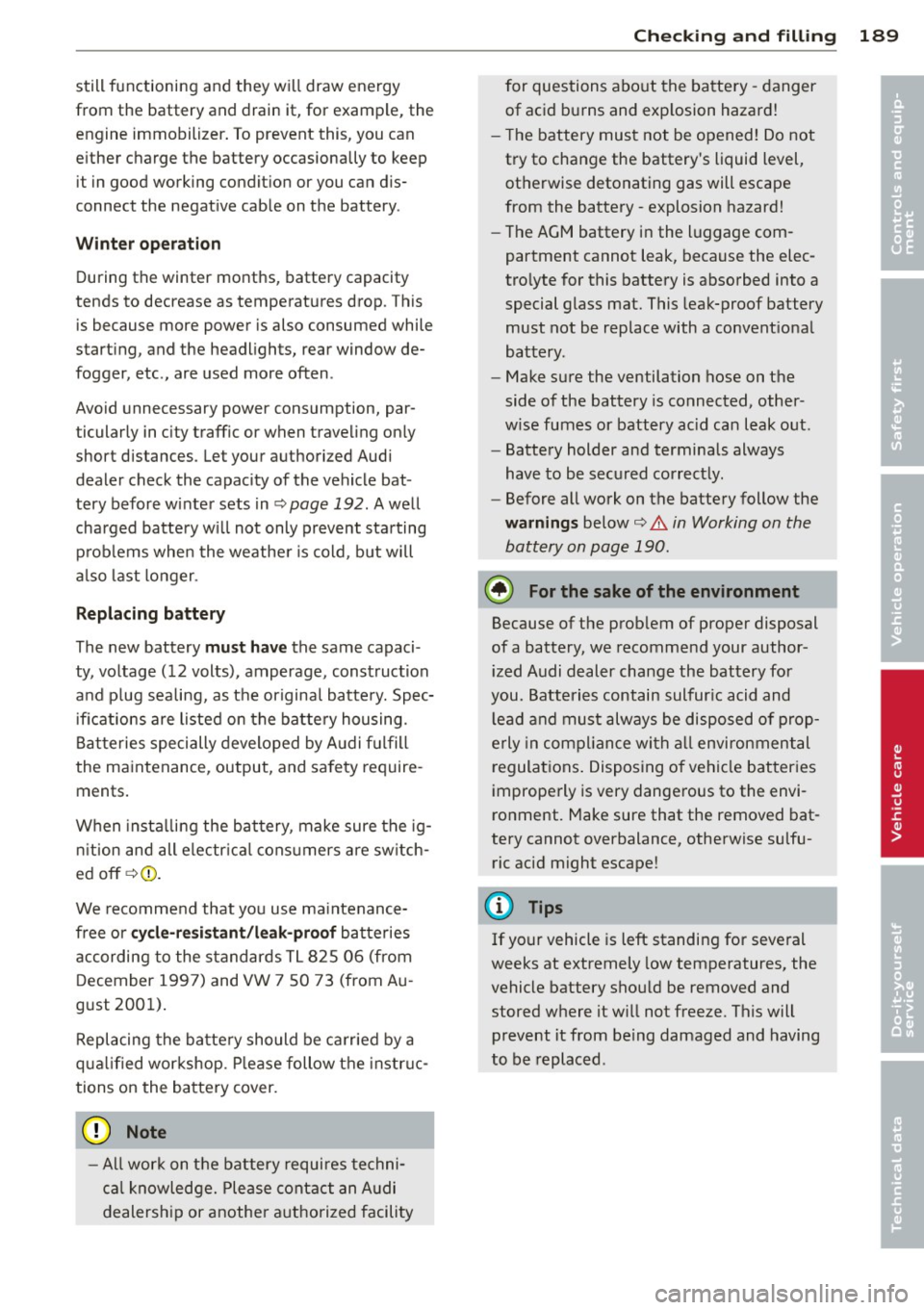
still functioning and they will draw energy
from the battery and drain it, for example, the
engine immobilizer . To prevent this, you can
e ither charge the battery occasionally to keep
it in good working condi tion or you can d is
connect the negat ive cable on the battery .
Winter ope ration
During the winter months, battery capacity
tends to decrease as temperatures drop . This
is because more power is also consumed while
start ing, and the headlights, rear window de
fogger, etc ., are used more often .
Avoid unnecessary power consumption, par
ticularly in c ity traffic or when traveling on ly
short distances. Let your authori zed Audi
dealer check the capacity of the vehicle bat
tery before winter sets in
¢ page 192. A well
charged battery w ill not only prevent starting
p rob lems when the weathe r is cold, but will
a lso last longer .
Replacing b attery
The new battery m ust have the same capaci
ty, voltage (12 volts), amperage, construction
a n d p lug sealing, as the origina l batte ry. Spec
ifications are listed on the batte ry housing.
Batteries specially developed by A udi f ulfill
the ma intenance, output, and safety require
ments.
When insta lling the bat tery , make sure the ig
n ition and all e lectr ica l cons umers are sw itch
ed
off ¢ (j) .
We recommend that you use ma intenance
free or
cy cle-re sis tant /le ak -proof batteries
according to the standards TL 825 06 (from
December 1997) and VW 7 SO 73 (from Au
gust 200 1).
Replacing the battery should be ca rried by a
qua lified workshop. Please follow the instruc
tions on the battery cover.
(D Note
- All work on t he battery requires techni
ca l knowledge. Please contact an A udi
dealership or anothe r authorized facili ty
Checkin g and fillin g 189
for questions abo ut the batte ry - danger
of acid burns and exp losion hazard!
- T he battery must not be opened! Do not
try to change the battery's liquid level,
otherwise detonating gas will escape
from the battery - explosion hazard!
- The AGM battery in the luggage com
partment cannot leak, because the elec
tro lyte for this battery is absorbed into a
special glass mat. This leak-proof battery
must not be replace with a convent iona l
battery.
- Make sure the ventilation hose on the
side of the battery is connected, other
w ise fumes or battery ac id can leak out.
- Battery holder and terminals always
have to be secured correctly.
- Before all work on the battery follow the
warnings below ¢.&. in Working on the
battery on page 190.
@) For the sake of the environment
Because of the prob lem of proper disposal
of a battery, we recommend your author
ized Audi dealer change the battery for
you. Batteries contain sulfur ic acid and
l ead and must always be disposed of prop
erly in compl iance with a ll environmental
regulat ions. Disposing of vehi cle batter ies
improperly is very dangerous to the envi
ronment. Make sure that the removed bat
tery cannot overbalance, otherwise sulfu ric acid might escape!
(D Tips
If your vehicle is left standing for several
weeks at extremely low temperatures, the
vehicle battery shou ld be removed and
stored where it w ill not freeze. This will
prevent it from be ing damaged and having
to be replaced . •
•
Page 192 of 260
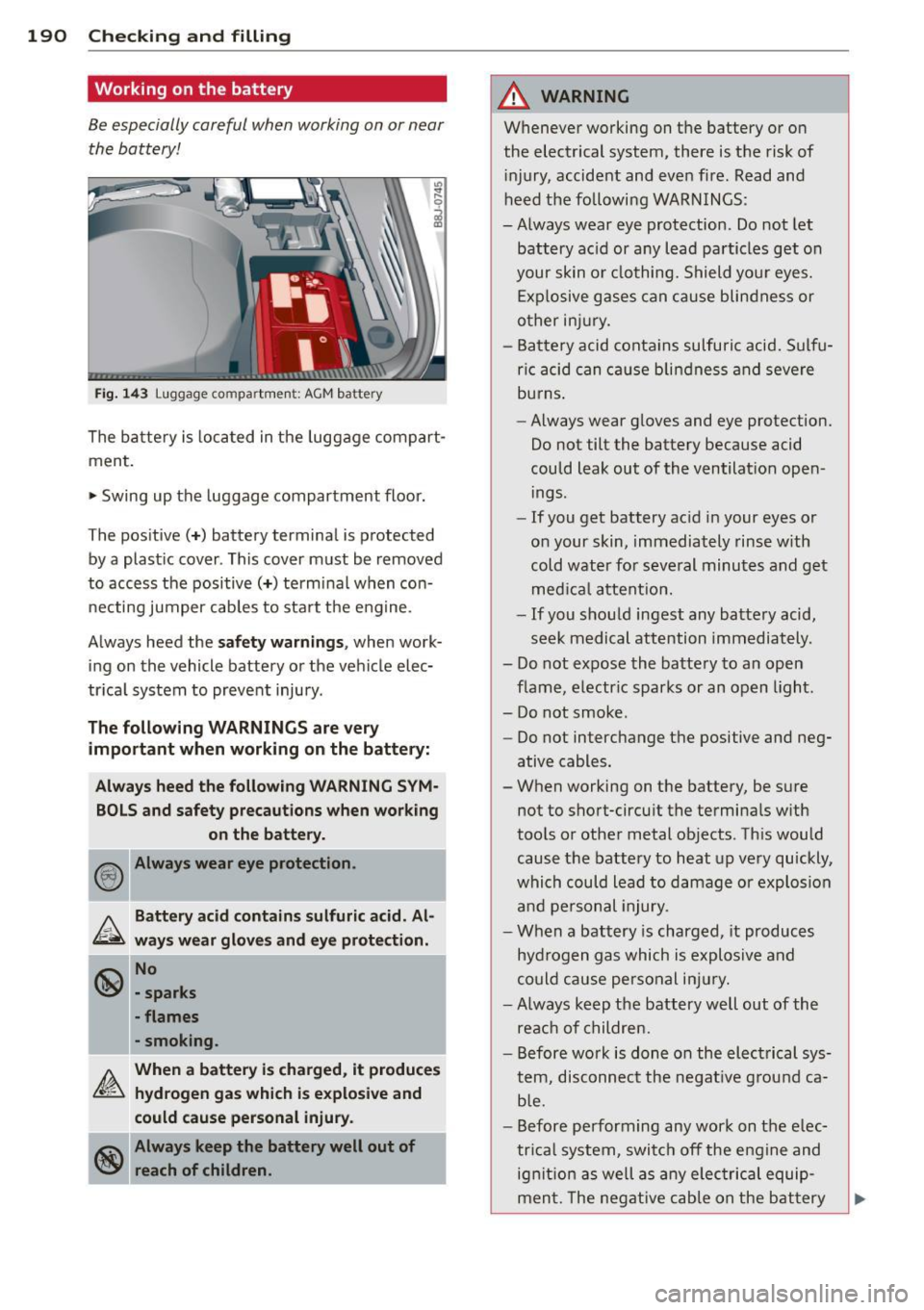
190 Checking and filling
Working on the battery
Be especially careful when working on or near
the battery!
Fig . 14 3 Luggage compartment: AGM battery
The battery is loca ted in the luggage compart
ment.
~ Swing up the luggage compartment floor.
The positive( +) battery terminal is p rotected
by a plast ic cover . This cover must be removed
to access the positive( +) termina l when con
necting jumper cables to start the eng ine .
Always heed the
safe ty war nings, when work
ing on the vehicle battery or the vehicle elec
tr ica l system to prevent injury .
The following WARN INGS are ver y
import ant when w orking on the battery:
Alw ays heed t he follow ing W ARNING SYM ·
BOLS a nd safety precautions wh en working
on th e bat tery.
® Always wear eye protection .
I).. Battery acid contain s sulfuric acid. Al
~ ways wear gl oves a nd e ye prot ecti on.
I/£ No
\l:!S' -spar ks
• flames
- smoking.
When a batter y is ch arged , it pr odu ce s
h y d rogen g as which i s ex plosi ve and
could cau se personal injury.
----Always keep the battery well out of
re ach of children .
®
.&_ WARNING
Whenever working on the battery or on
the elect rical system, there is the risk of
i njury, accident and even fire. Read and
heed the fo llowing WARNINGS:
-Always wear eye protection. Do not let battery ac id or any lead particles get on
your skin o r clothing. Shield your eyes.
E xp losive gases can cause blindness or
o ther inju ry.
- Ba ttery acid conta ins sulfuric acid. Sulfu
ric acid can ca use blindness and severe
burns .
- Always wear gloves and eye protection.
Do not tilt the battery because acid
could leak out of the ventilat ion open
ings .
- If you get battery acid in your eyes or
on your skin, immediately rinse w ith
cold water for several minutes and get
medica l attent ion.
- If you shou ld ingest any battery acid,
seek medical attention immediately.
- Do not expose the battery to an open flame, e lectr ic sparks or an open light .
- Do not smoke.
- Do not interchange the positive and neg-
ative cables.
- When working on the battery, be sure
not to short-circuit the terminals with
tools or other metal objects . Th is would
cause the battery to heat up very quickly,
which could lead to damage or explosion and personal injury.
- When a battery is charged, it produces
hydrogen gas which is explos ive and
could cause pe rsonal in ju ry.
- Always keep the battery well out of the
reac h of children.
- Before work is done on the electrical sys
tem, disconnect the negat ive g round ca
b le.
- Before performing any work on the e lec
tr ica l system, switch off the engine and
ignit ion as well as any elec trical equip
ment. The negative cable on the bat tery
Page 193 of 260
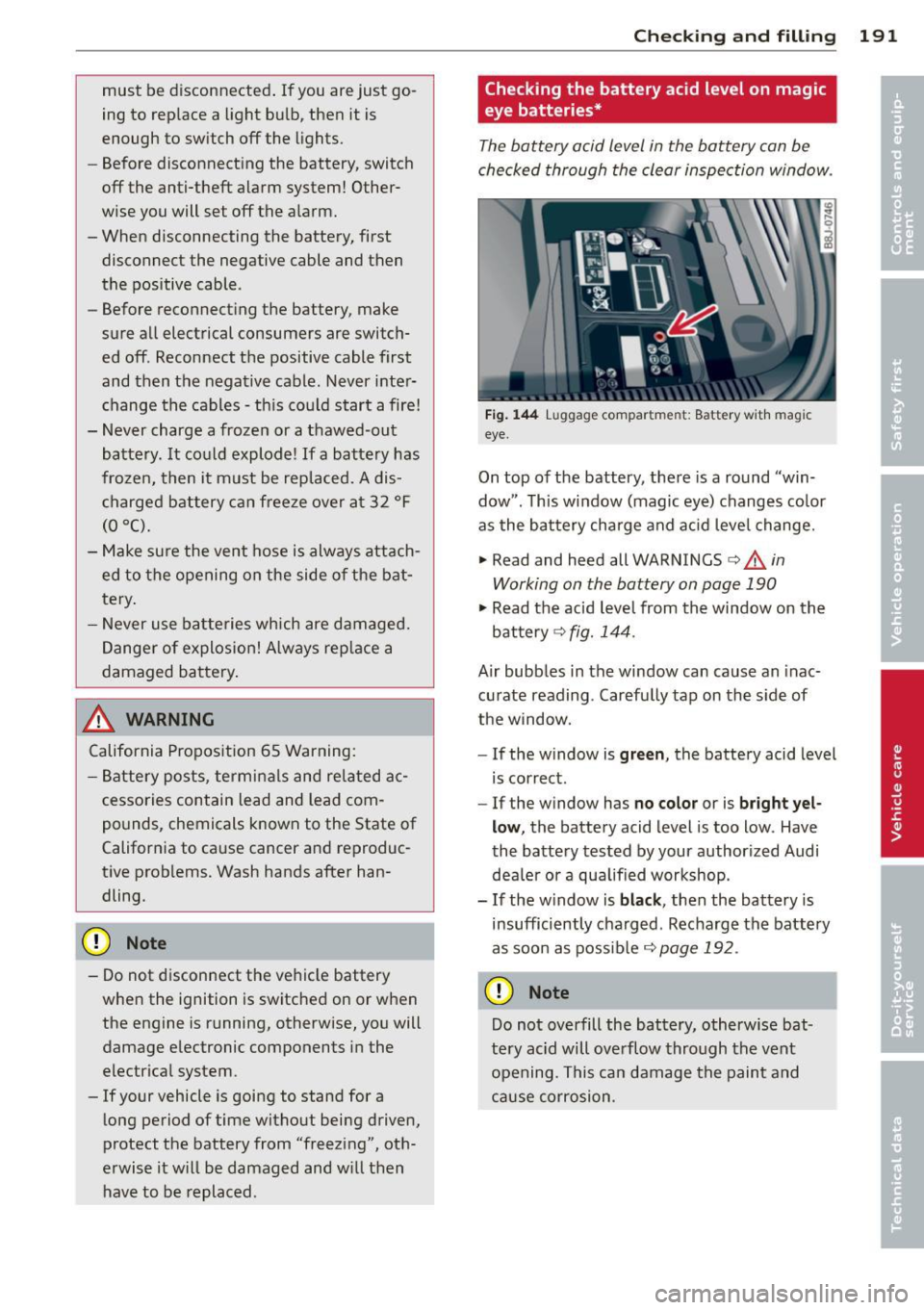
must be disconnected. If you are just go
ing to replace a light bulb, then it is
enough to switch off the lights.
- Before disconnecting the battery, switch
off the anti-theft alarm system! Other
wise you will set off the alarm.
- When disconnecting the battery, first
disconnect the negative cable and then
the positive cable.
- Before reconnecting the battery, make
sure all electrical consumers are switch
ed off. Reconnect the positive cable first
and then the negative cable. Never inter
change the cables -this could start a fire!
- Never charge a frozen or a thawed-out battery. It could explode! If a battery has
frozen, then it must be replaced. A dis
charged battery can freeze over at 32 °F
(0 oc).
-Make sure the vent hose is always attach
ed to the opening on the side of the bat
tery.
- Never use batteries which are damaged.
Danger of explosion! Always replace a
damaged battery.
A WARNING
California Proposition 65 Warning:
- Battery posts, terminals and related ac
cessories contain lead and lead com
pounds, chemicals known to the State of
California to cause cancer and reproduc
tive problems. Wash hands after han
dling.
CD Note
- Do not disconnect the vehicle battery
when the ignition is switched on or when
the engine is running, otherwise, you will
damage electronic components in the
electrical system.
- If your vehicle is going to stand for a
long period of time without being driven,
protect the battery from "freezing", oth
erwise it will be damaged and will then have to be replaced.
Checking and filling 191
Checking the battery acid level on magic
eye batteries*
The battery acid level in the battery can be
checked through the clear inspection window .
Fig. 144 Luggage compartment: Battery With magic
eye.
On top of the battery, there is a round "win
dow". This window (magic eye) changes color
as the battery charge and acid level change.
.. Read and heed all WARNINGS
c::> &_ in
Working on the battery on page 190
.. Read the acid level from the window on the
battery
c:> fig. 144.
Air bubbles in the window can cause an inac
curate reading . Carefully tap on the side of
the window.
- If the window is
green, the battery acid level
is correct.
- If the window has no color or is bright yel
low ,
the battery acid level is too low . Have
the battery tested by your authorized Audi
dealer or a qualified workshop.
- If the window is
black , then the battery is
insufficiently charged . Recharge the battery
as soon as possible
r:::, page 192 .
CD Note
Do not overfill the battery, otherwise bat
tery acid will overflow through the vent
opening. This can damage the paint and
cause corrosion .
Page 194 of 260
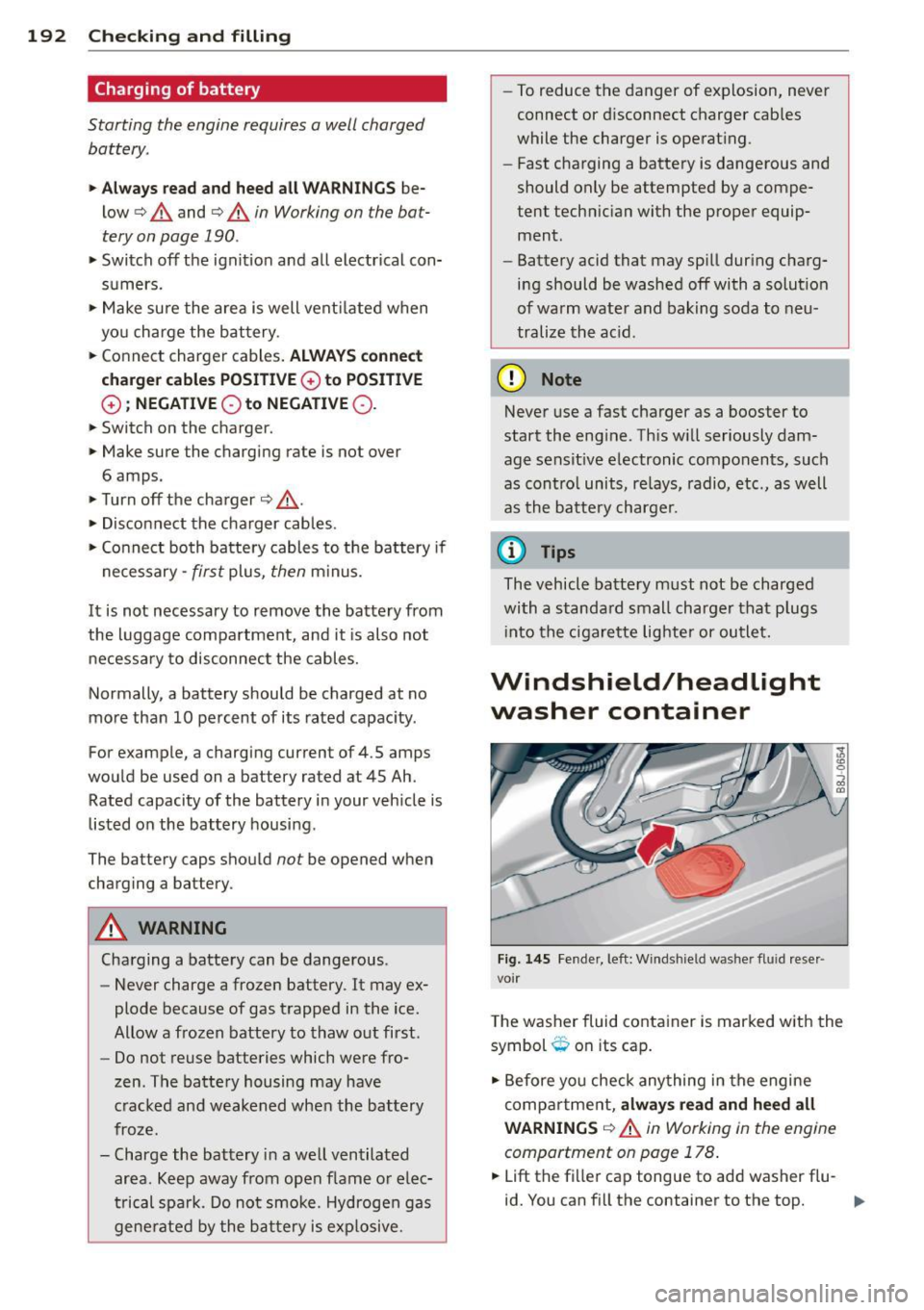
192 Checking and filling
Charging of battery
Starting the engine requires a well charged battery.
,. Always read and heed all W ARNIN GS be
low
c> A and c> A in Working on the bat
tery on page 190.
,. Switch off the ignitio n and all electrical con
s u mers.
,. Make sure the area is well vent ilated when
yo u charge the battery.
,. Connect charger cables.
ALWAY S co nnect
ch arg er ca ble s PO SITIV E
G) to POSITIVE
G) ; NE GATI VE Q to NEGATI VE Q .
,. Switch on the charger.
,. Make sure the charging rate is not over
6 amps.
,. Turn off the charger¢.&_.
,. Disconnect the charger cables .
,. Connect both battery cables to the battery if
necessary-
first plus, then m inus.
It is not necessary to remove the battery from
the luggage compartment, and it is also not
necessa ry to disconnect the cables.
Normally, a battery should be charged at no
more than 10 percent of its rated capacity.
For example, a charging current of 4.5 amps
wou ld be used on a battery rated at 45 Ah.
Rated capacity of the battery in your veh icle is
listed on the battery housing .
The battery caps should
not be opened when
charging a battery.
&,. WARNING
-
Charging a battery can be dangerous.
- Never charge a frozen battery . It may ex
plode because of gas trapped in the ice.
Allow a frozen battery to thaw out first.
- Do not reuse batteries which were fro
zen. The battery housing may have
c racked and weakened whe n the battery
froze.
- Charge the battery in a we ll ventilated
area . Keep away from open f lame o r elec
t ric al spa rk . Do not smoke. Hydrogen gas
gene rate d by the b attery is exp losive. -
To reduce the danger of explosion, never
connect or d isconnect charger cab les
while the charger is operating .
- Fast charging a battery is dangerous and
should only be attempted by a compe
tent tech nician with the proper equip
ment .
- Battery acid that may spill during charg
ing should be washed off with a solution
of wa rm water and bak ing soda to neu
tralize th e ac id .
(D Note
Never use a fast charger as a booster to
start the eng ine . Th is w ill seriously dam
age sensit ive electronic components, such
as cont ro l units, re lays, radio, etc., as well
as the battery charger.
{1) Tips
The vehicle batte ry must not be charged
with a standa rd small charger that p lugs
i nto the cigarette lig hter or outlet.
Windshield/head Light
washer container
Fig . 14 5 Fender, left: Windshie ld washer fluid reser·
vo ir
T he washer fluid container is marked with the
symbol
O on its cap.
,. Before you check any thing in the engine
compa rtme nt,
a lwa ys read and heed all
WARNINGS ¢
A in Working in the engine
compartment on page 178 .
,. Lift the filler cap tongue to add washer flu-
id. You can fill the container to the top.
111>
Page 195 of 260

~ Press the cap back onto the filler neck after
filling the container .
You can find the reservoir
c ap acit y in the tab le
in
c::> page 239.
C lean water should be used when filling up. If
possible, use soft wate r to prevent scal ing on
the w asher jets. Always add a glass cleaner
solution (with frost protection in the winter) .
(D Note
Do not mix engine coolant antifreeze or
any other add itives to fi ll up the wind
shie ld washer reservoir.
Checkin g and fillin g 193
•
•
Page 196 of 260
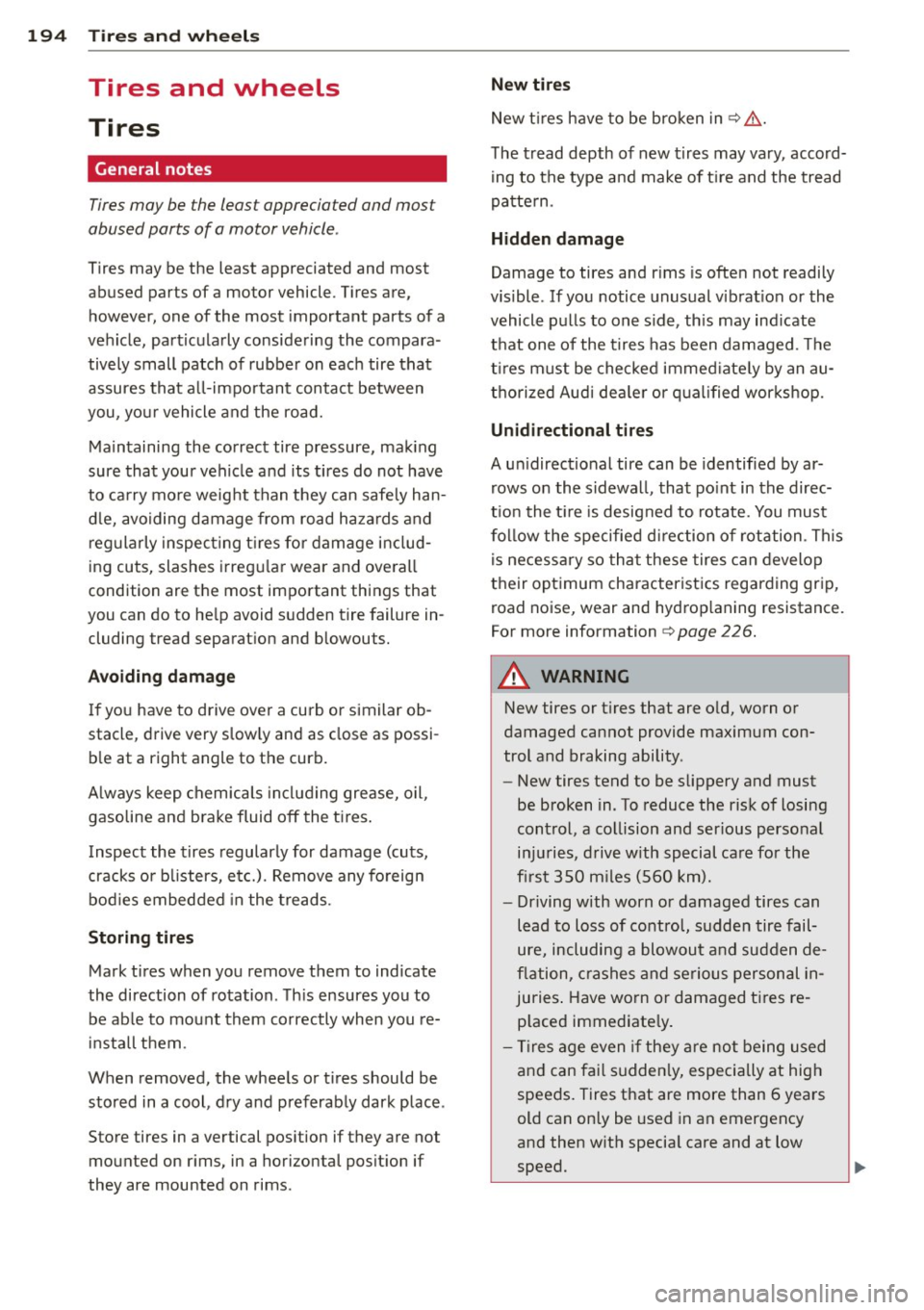
194 Tire s and wheel s
Tires and wheels
Tires
General notes
Tires may be the least appreciated and most
abused parts of a motor vehicle .
Tires may be the least appreciated and most
abused parts of a motor vehicle . Tires are,
however, one of the most important parts of a
vehicle, particularly considering the compara
tive ly small patch of rubber on each tire that
assures that a ll-important contact between
you, you r vehicle and the road.
Maintaining the correct tire pressure, mak ing
sure that your veh icle and its t ires do not have
to carry mo re weight than they can safe ly han
d le, avoiding damage from roa d haza rds and
r eg ularly inspecting t ires for damage includ
ing cuts, slashes irregu la r wear and ove rall
condition are the most important things that
you can do to he lp avoid s udden tire failure in
cluding tread separat ion and blowouts.
Avoiding damage
If you have to drive over a curb or similar ob
stacle, drive very s low ly and as close as possi
b le at a right angle to the curb.
A lways keep chem ica ls incl ud ing gre ase, o il,
gasoline and b rake fluid off the t ires .
Inspect the t ir e s regularly for damage (cuts,
cracks or b listers, etc.). Remove any fo reign
bod ies embedded in the treads.
Storing tires
Mark ti res when you remove them to indicate
the direction of rotation . T his ensures you to
be ab le to mount them correctly when you re
install t hem.
When removed, the whee ls or t ires should be
stored in a cool, d ry and preferably dark place .
Store tires in a vertical pos ition if they are not
mounted on rims, in a horizontal pos it ion if
they are mounted on rims.
New tires
New t ires have to be broken in¢&,. .
T he tread depth of new t ires may vary, accord
ing to the type a nd make of t ire and the tread
pa tte rn .
Hidden damage
Damage to tires and r ims is ofte n not readily
vis ible . If you notice unusual v ibrat ion or the
vehicle p ulls to one side, th is may ind icate
t h at one of the t ires has been damaged . Th e
t ir es m ust be checked immed iate ly by an au
tho rized Aud i dea le r or q uali fied wor ks hop.
Unidirectional t ires
A un idirectional tire can be identified by ar
rows on the sid ewa ll, that po int in the direc
t ion the t ire is desig ned to rotate. You must
f ol low the specified d irec tion of rot ation . This
is necessa ry so tha t these tires can develop
their optimum characterist ics regarding grip,
road no ise, wear and hyd rop laning resistance.
For more information ¢
page 226.
A WARNING
-New tires or t ires that are o ld, worn or
damaged cannot provide maximum con
trol and braking ability .
-
-New tires tend to be slippery and must
be broken in . To reduce the risk of losing
control, a co llision and ser ious personal
in jur ies, d rive w ith special ca re fo r the
fi rst 3 50 m iles (560 km).
- Driving with worn or damaged tires can
le ad to loss of control, sudden tire fail
ure, including a blowou t and sudden de
fla tion, crashes and seriou s personal in
juries . Have wo rn or damaged t ires re
p laced immediate ly .
- Ti res age even if they are not being used
an d can fai l sudden ly, especially at high
speeds. Tires that are more than 6 years
old can only be used in an emergency
and then w ith specia l care and at low
speed.
Page 197 of 260
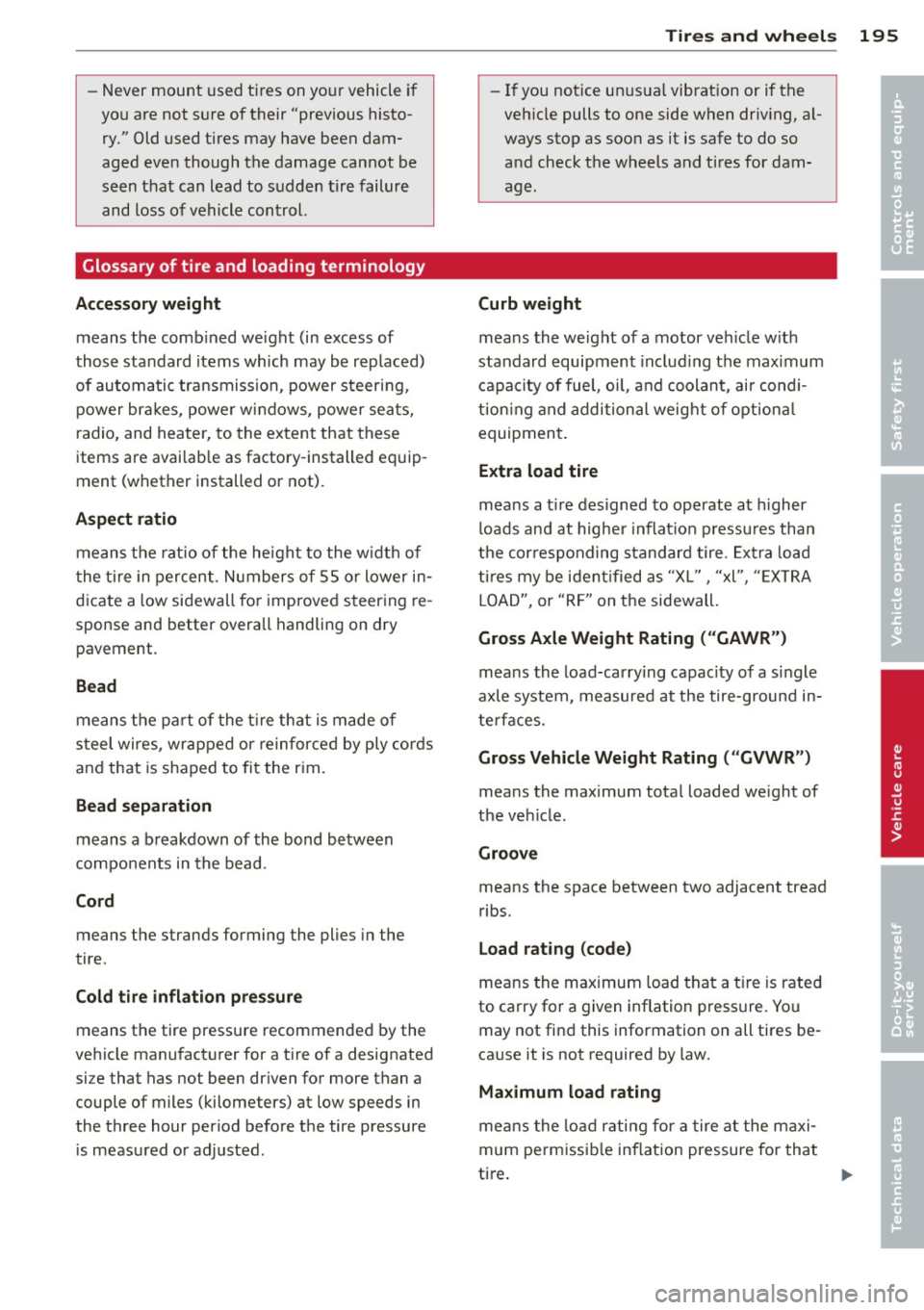
-Never mount used tires on yo ur vehicle if
you are not sure of their "previous histo
ry." Old used tires may have been dam
aged even though the damage cannot be
seen that can lead to sudden tire failure
and loss of vehicle control.
Glossary of tire and loading terminology
Accessory weight
means the comb ined weight (in excess of
those standard items wh ich may be rep laced)
of automa tic tra nsmission, power steering,
power br akes, power w indows, power sea ts,
radio, and heater, to the ex tent that these
items are avai lab le as factory -installed eq uip
ment (whether installed or not).
Aspect ratio
means the rat io of the height to the w idt h of
the tire in percent . Numbers of 55 o r lower in
d icate a low sidewall fo r improve d steer ing re
sponse and better overall handling on dry
pavement.
Bead
means the pa rt of the t ire t hat is made o f
s teel wires, wrapped o r reinforce d by ply cor ds
and that is shaped to fit the r im.
Bead separation
means a b reakdown of the bond between
com ponents in the bead .
Cord
means the strands forming the plies in the
tire .
Cold tire infl ation pres sure
means the tire pressure recommended by the
vehicle manufacturer for a t ire of a designated
size that has not been dr iven for more than a
couple of miles (kilometers) at low speeds in
the three hour period before the tire pressure
i s measu red or adjusted.
Tire s an d wheel s 195
-If you notice un usua l vibration or if the
veh icle pulls to one side when driv ing, a l
ways stop as soon as it is safe to do so and check the wheels and tires for dam
age.
Curb weight
mea ns the we ight of a motor ve hicle w it h
standard equipment in cl ud ing t he maximum
capacity of fuel, o il, and coolant, ai r cond i
tion ing and addi tional weig ht o f optiona l
equipment .
Extra load tire
means a t ire designed to operate at higher
loads and at highe r inflat ion p ressu res tha n
th e co rresponding standard tire. Extr a load
tir es my be i dent ified as "X L", "xl", " EXTRA
L O AD", or "RF" on t he sidewall.
Gross Axle Weight Rating ("GAWR ")
mea ns the load-carry ing capac ity of a s ingle
axle system, measured at the tire-ground in
te rfaces .
Gross Vehicle Weight Rating ( "GVWR ")
mea ns the maximum total loaded we ight of
t h e ve hicle.
Groove
means the space between two adjacent tread
ribs.
Load rating (code )
means the maximum load tha t a t ire is rate d
to ca rry for a given inflation press ure. Yo u
may not find this information on all tires be
ca use it is not required by law.
Maximum load rating
me ans the loa d ra ting f or a t ire a t the maxi
mum pe rm issi ble inflat ion pressure for that
ti re . •
•
...
Page 198 of 260
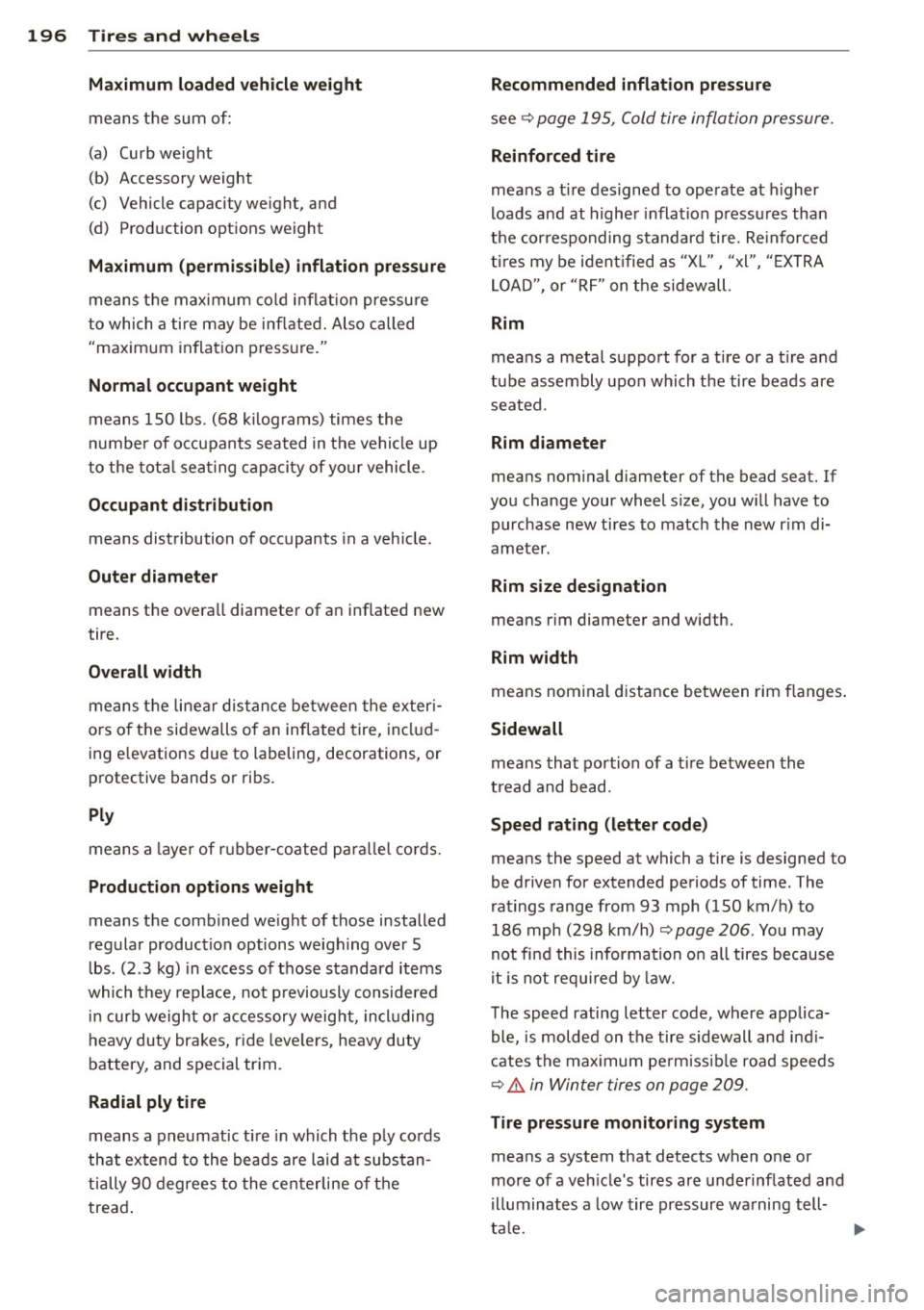
196 Tires and wheels
Maximum loaded vehicle weight
means the sum of:
(a) Curb weight
(b) Accessory weight
(c) Vehicle capacity we ight, and
(d) Production options weight
Maximum (permissible) inflation pressure
means the maximum cold inflation pressu re
to which a tire may be inflated. Also called
"maximum inflation p ressure."
Normal occupant weight
means 150 lbs. (68 kilograms) times the
number of occupants seated in the vehicle up
to the total seating capacity of your vehicle.
Occupant distribution means distribution of occupants in a vehicle .
Outer diameter means the overa ll diameter of an inf lated new
tire.
Overall width
means the linear distance between the exteri
ors of the sidewalls of an inflated tire, includ
ing e levations due to labeling, decorations, or
protective bands or ribs.
Ply
means a laye r of rubber-coated parallel cords.
Production options weight
means the comb ined we ight of those installed
regular production options weighing over 5
lbs . (2 .3 kg) in excess of those standard items
which they replace, not previously considered
in curb weight or accessory weight, including
heavy duty brakes, r ide leve lers, heavy duty
battery, and special trim.
Radial ply tire
means a pneumatic tir e in which the p ly cords
that extend to the beads are laid at substan
tially 90 degrees to the centerline of the
tread . Recommended inflation pressure
see
~
page 195, Cold tire inflation pressure.
Reinforced tire
means a t ire designed to operate at higher
loads and at higher inflation p ressures than
the corresponding standard tire. Reinforced
ti res my be ident ified as "XL" "xl" "E XTRA
, ,
LOAD", or "RF" on the sidewall.
Rim
means a metal support for a tire or a t ire and
tube assembly upon which the tire beads are seated.
Rim diameter
means nominal d iameter of the bead seat. If
you change your wheel s ize, you w ill have to
purchase new tires to match the new r im di
ameter .
Rim size designation
means rim diameter and width.
Rim width
means nominal distance between rim flanges .
Sidewall
means that portion of a tire between the
tread and bead.
Speed rating (letter code)
means the speed at which a tire is designed to
be driven for extended periods of time. The
r atings range from 93 mph (150 km/h) to
186 mph (298 km/h)
~ page 206 . You may
not find this information on all tires because
it is not requ ired by law.
T he speed rating letter code, where applica
ble, is molded on the tire sidewall and indi
cates the maximum perm iss ibl e road speeds
~ A in Winter tires on page 209 .
Tire pressure monitoring system
means a system that detects when one or
more of a veh icle's tires are underinflated and
i lluminates a low tire pressure warning tell-
tale. ..,_
Page 199 of 260
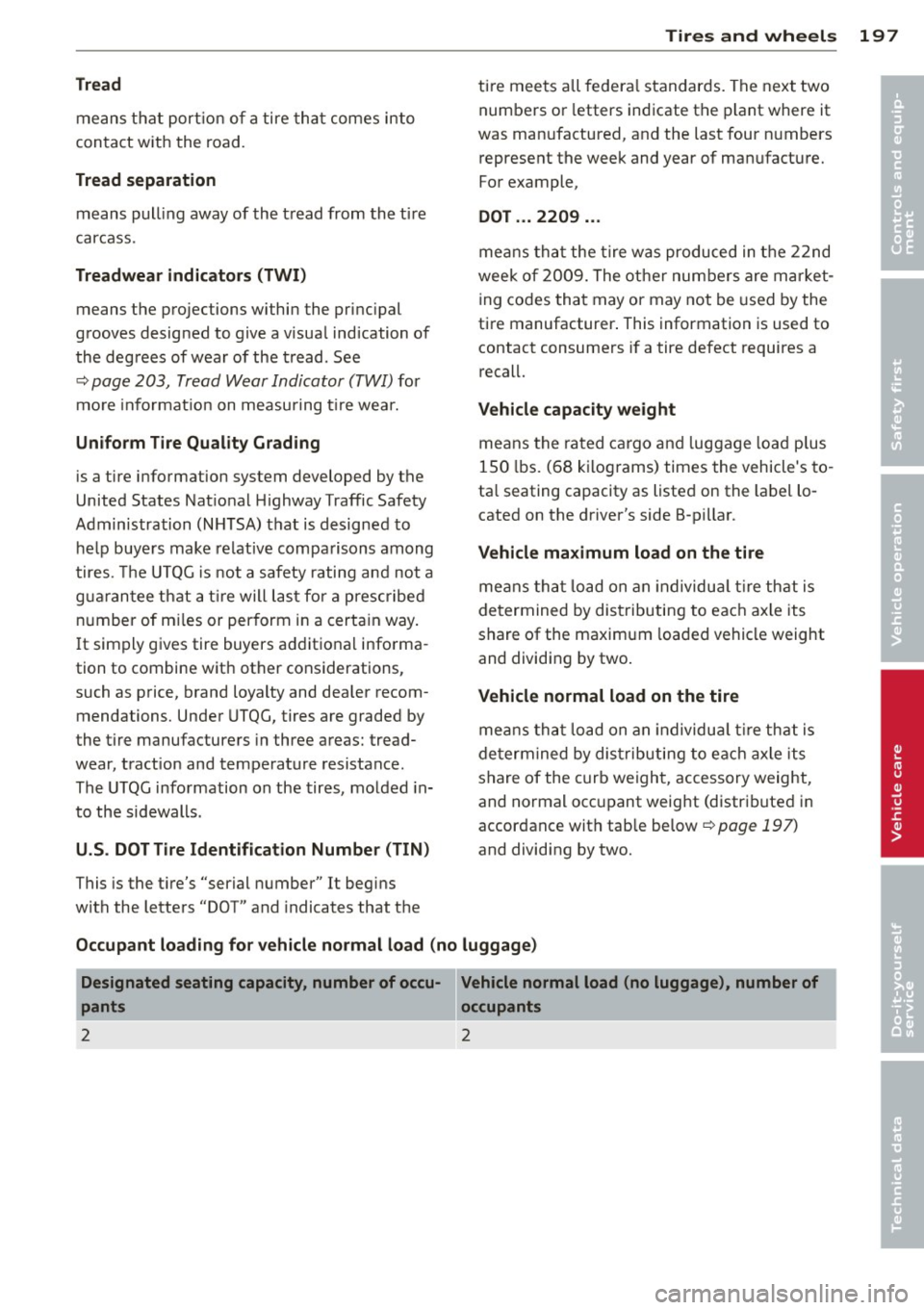
Tires and wheels 197
Tread
means that portion of a tire that comes into
contact with the road.
Tread separation
means pull ing away of the tread from the tire
carcass .
Treadwear indicators (TWI)
means the projections within the principal
grooves designed to give a visual indication of
the degrees of wear of the tread. See
c:> page 203, Tread Wear Indicator (TWI) for
more informat ion on measuring tir e wear.
Uniform Tire Quality Grading
is a tire information system developed by the
United States National Highway Traffic Safety
Administration (NHTSA) that is designed to help buyers make relative comparisons among
tires. The UTQG is not a safety rating and not a
g uarantee that a tire will last for a prescribed
number of mi les or per form in a certain way.
It simply gives tire buyers additional informa
tion to combine with other considerations,
such as price, brand loyalty and dea ler recom
mendations. Under UTQG, tires are graded by
the tire manufacturers in three areas: tread
wear, traction and temperature resistance.
The UTQG information on the tires, molded in
to the sidewalls .
U.S. DOT Tire Identification Number (TIN)
This is the t ire's "serial number" It begins
with the letters "DOT" and indicates that the tire meets
all federal standards. The next two
numbers or letters indicate the plant where it
was manufactured, and the last four n umbers
represent the week and year of man ufacture.
For example,
DOT . .. 2209 ...
means that the tire was produced in the 22nd
week of 2009. The other numbers are market
ing codes that may or may not be used by the
tire manufacturer . This information is used to
contact consumers if a tire defect requires a
recall.
Vehicle capacity weight
means the rated cargo and luggage load plus
150 lbs. (68 kilograms) times the vehicle's to
ta l seating capacity as listed on the label lo
cated on the driver's side B-pillar.
Vehicle maximum load on the tire
means that load on an individua l tire that is
determined by distributing to each axle its
share of the maximum loaded vehicle weight
and dividing by two.
Vehicle normal load on the tire
means that loa d on an individua l tire that is
determined by distributing to each axle its
share of the curb weight, accessory weight,
and normal occ upant weig ht (distributed in
accordance with tab le below
c:> page 197)
and dividing by two.
Occupant loading for vehicle normal load (no luggage)
Designated seating capacity, number of occu- Vehicle normal load (no luggage), number of
pants occupants
2 2
•
•
Page 200 of 260
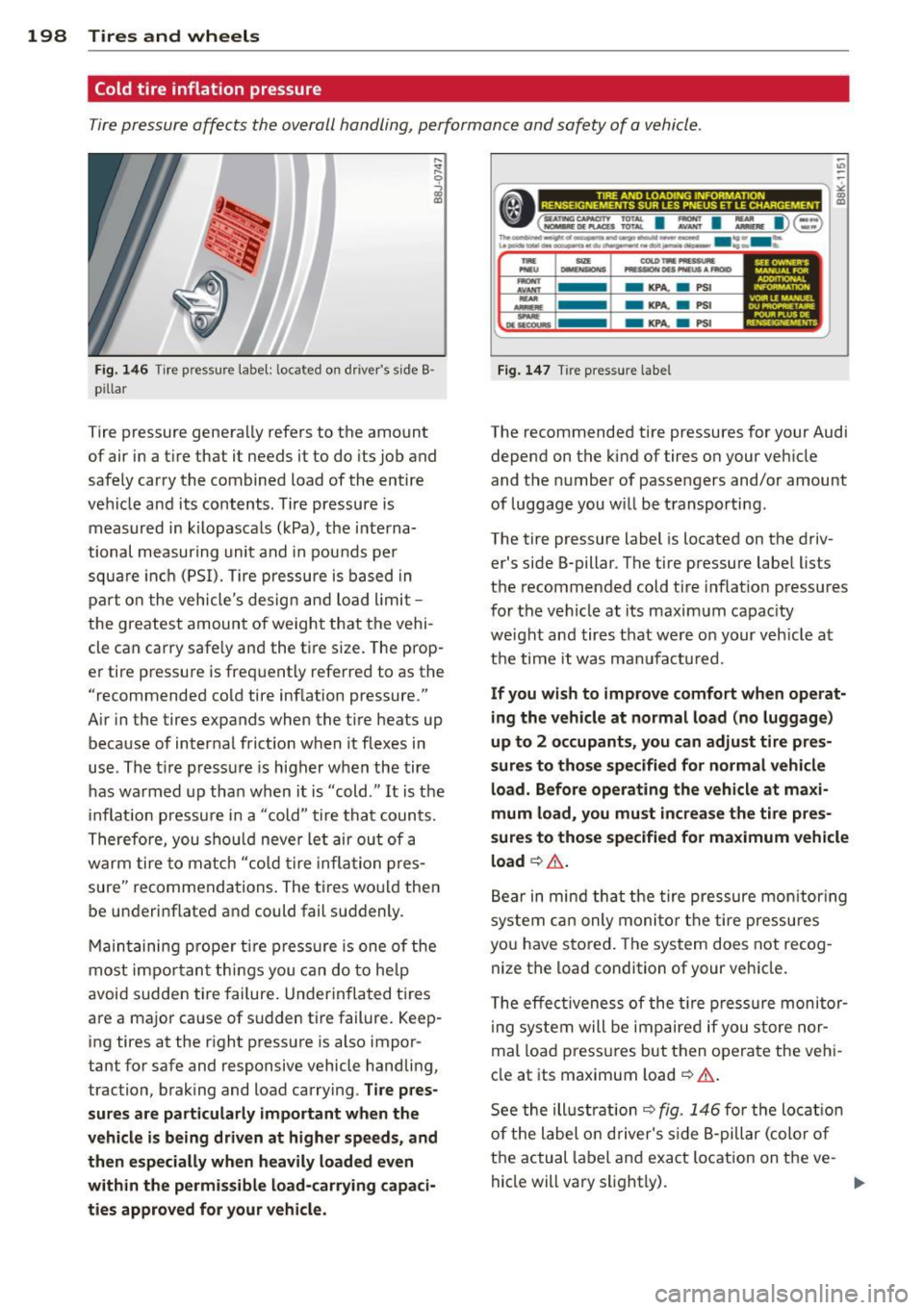
198 Tires and whe els
Cold tire inflation pressure
Tire pressure affects the overall handling, performance and safety of a vehicle .
Fig. 14 6 Tire p ress ure labe l: loca ted on dr iver 's side B ·
p ill ar
Tire pressure generally refers to the amount
of air in a t ire that it needs it to do its job and
safely carry the combined load of the entire
vehicle and its contents . Tire pressure is
measured in kilopasca ls (kPa), the interna·
tional measuring unit and in pounds per
squa re inch (PSI). Tire pressure is based in
part o n the vehicle's design and load limit
the greatest amount of weight that the vehi·
cle can carry safe ly and the t ire size. The prop·
er tire pressure is freq uently referred to as the
"recommended cold tire inflation pressure."
A ir in the tires expands when the tire heats up
because of internal frict ion when it flexes in
use . The t ire p ressure is higher when the tire
has warmed up than when it is "cold ." It is the
i n flat ion pressure in a "cold " tire that counts.
Therefore, you shou ld neve r let air ou t of a
warm tire to match " co ld tir e infla tion p res
sure" recommendations . The tires wo uld then
be underinflated and could fail su ddenly .
M aintaining p roper t ire press ure is one o f the
most impo rtan t things you can do to he lp
avoid sudden tire failure. Underinflated ti res
are a major cause of s udden tire failure. Keep
ing tires at the right pressure is also impor
tant for safe and responsive vehicle handling,
traction, braking and load carrying .
Tir e pres
s ur es are part icularly important wh en th e
vehicl e is being driven at higher speed s, and
then es pecially wh en heav ily loaded even
w ithin th e permis sible load -carrying capa ci
tie s approv ed for y our vehi cle.
,;
•(=~: I : I :,.. I)@ ~
The~-----~---w-o- ....... -e.....i -·· - u ........ -.-..,.0, ... -....,.,...tot~---....... ._.,. -..
....
-..... ...........
- KPA. a PSI
- KPA.
a PSI
- KPA.
a PSI
Fig . 14 7 Tir e pressure labe l
SEE OWNER'S MANUAl FOR
A DOMlONAL
T10N VOl!ILEMANU£1. DU _,...,
POUR P\.US DE
REHSEKiloiEMENTS
The recommended tire pressures for your Audi
depend on the kind of tires on your veh icle
and the number of passengers and/or amount
of luggage you w ill be transporting .
The tire pressure label is located on the driv
er's side B-pillar . The tire pressure label lists
the recommended cold t ire inflat io n pressures
for the vehicle at its maxim um capac ity
we ight and tires that were on your veh icle at
the time it was manufa ctu red .
If you wish to impro ve comfort when operat
ing the v ehicle at normal lo ad (no luggag e)
up to 2 occupant s, you can adju st ti re pr es
sures to tho se spe cified f or normal vehi cle
load. Before oper ating th e vehicl e at maxi
mum load, yo u must increase the tire pr es
sure s to tho se spe cified f or ma ximum vehicle
load ~.&. .
Bear in mind that the tire pressure mon itor ing
system c an only moni to r the tire pressu res
you have stored. The sys tem does not recog
nize the load condition of your veh icle.
T he effec tiveness of the t ire press ure monitor
i ng system will be impaire d if you store nor
mal load pressures but then operate the vehi
cle at its maximum load
~ .&. .
See the ill ustration ~ fig. 146 fo r the locat io n
of the label on d river 's s ide B-pillar (colo r of
the actual label and exact location on the ve-
hicle will vary slight ly) .
IJi,,